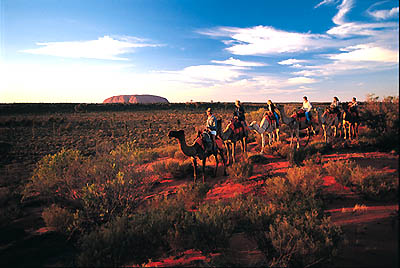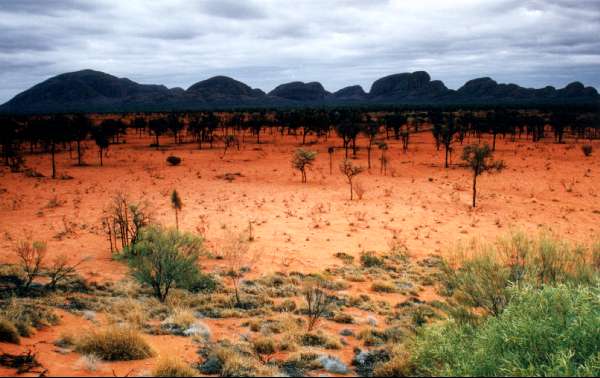

Ayers Rock (Mount Uluru) is believed to have had its beginnings in the Precambrian era about 550 million years ago. Enormous mountain ranges were pushed up then eroded away over the next 200 million years, leaving the Mann, Musgrave and Petermann Ranges in Central Australia.
The sediments from these ranges was laid down on the Amadeus Basin, and further earth movements about 300 million years ago and an erosion process that continues even now at a very slow rate, began to create the spectacular features we see today.
Consisting of Arkose, a course-grained sandstone rich in the mineral feldspar, Ayers Rock achieves its famous red colour and flaky surface from the chemical decay of minerals and mechanical erosion. The characteristic rusty colour of the exposed surface of these flakes is just that rust. It is caused by the oxidation or rusting of the iron in the arkose. The fresh arkose is a grey colour.The sculptured shapes of the Rock are a combination of mechanical erosion and other events such as chemical changes caused by moisture.
Rising 862.5 metres above sea level (345 metres above the ground), Ayers Rock covers an area of 3.33 square kilometers. It has a circumference of 9,4 kilometres, a maximum width of 2,0 kilometres and a maximum length of 3,1 kilometres.
Ayers Rock is situated in the Uluru (Ayers Rock-Mount Olga) National Park, Northern Territory, Australia.
The first white person to reach and climb the Rock was William Christie Gosse in 1873. He named it after Sir Henry Ayers, then Chief Secretary and later Premier of South Australia. Aboriginal people are believed to have lived around Ayers Rock for several thousand years, and their name for Ayers Rock, "Uluru" is simply a place name without any special meaning.
Where is Uluru? Ayers Rock, known as Uluru since the land was returned to the traditional owners (the aboriginal people of the area), is 450km south west of Alice Springs. Climbers and non-climbers will find plenty to explore and examine at this Central Australian icon and can learn about its spiritual and cultural significance to the local aboriginal population. At Sunset visitors armed with cameras attempt to catch the changing hues of The Rock from Sunset Strip.
Equally spectacular are the Olgas (Katatjuta, meaning Many Heads) including the Olga Gorge - a must-see for any visitor to the Uluru-Kata Tjuta National Park Kings Canyon (at Watarrka National Park) offers a range of walks and climbs to views of the stunning landscape of Central Australia.
Arabian or One Humped Camel
 Species: Camelus dromedarius
Species: Camelus dromedarius
These massive "ships of the desert" can weigh up to 650kg or 1450lbs. They can be found in the deserts of Africa, south west Asia and even feral (once tame, now wild) in Australia.
Camels are perfect mammals for the desert; their body temperature can swing amazingly, their eyes and nose have special adaptations to keep out sand, and they can digest things like saltbrush, thorns and dry vegetation. Camels consume a lot of things that other animals would literally starve to death before eating. They can also store water in their bodies and last up to ten months without actually taking a drink!
Frontier Camel Farm Tours

Sit back and let their friendly camels carry you off the beaten track to watch the Sunrise or Sunset from the tallest seats in town. Operating daily departing 1 hour before sunrise. Nick ,the owner, picked us up and took us to the camels corral. He harnessed all the camels, while we grabbed our blanket to sit on. All along the way Nick showed us different vegetation, mentioned lizards, geckos
geckos  and discussed the camels life style. The sunrose and we saw "camels" view of Ayers Rock. Once back to the corral we had billy tea and snacks which were delicious. Nick drove all the other cameliers back to the resort and upon his return we watched the camels being unharnessed and fed. Each camel had it's own personality in dealing with Nick. It was amazing to observe his relationship with them.
and discussed the camels life style. The sunrose and we saw "camels" view of Ayers Rock. Once back to the corral we had billy tea and snacks which were delicious. Nick drove all the other cameliers back to the resort and upon his return we watched the camels being unharnessed and fed. Each camel had it's own personality in dealing with Nick. It was amazing to observe his relationship with them.
Our next activity was to see The Olgas, equally spectacular (Katatjuta, meaning Many Heads). The Olgas are a majestic series of domes set 50 kilometres from Ayers Rock Resort. A total of 36 domes make up Kata Tjuta (Olgas). We learned the Australian salute,swatting all the little black flies, while waiting for the sunset. They were some of the most irritating bugs any of us have ever experienced.
 Our hostel, part of then remote Yulara Resort, had 4 units to a building with a common eating area. For dinner you chose your meat: beef, chicken or crocodile and cooked it yourself on a large hot grill, ate at long tables wherever you could find a seat and listened to live music.
Breakfast and lunch were bought from a small take-out or if you had brought your food with you, one could cook it in the common cooking area.
Our hostel, part of then remote Yulara Resort, had 4 units to a building with a common eating area. For dinner you chose your meat: beef, chicken or crocodile and cooked it yourself on a large hot grill, ate at long tables wherever you could find a seat and listened to live music.
Breakfast and lunch were bought from a small take-out or if you had brought your food with you, one could cook it in the common cooking area.
If you have any suggestions or questions email me:
| Main Page | Brisbane | Cairns | Melbourne | New Zealand | Fiji | Go to top |